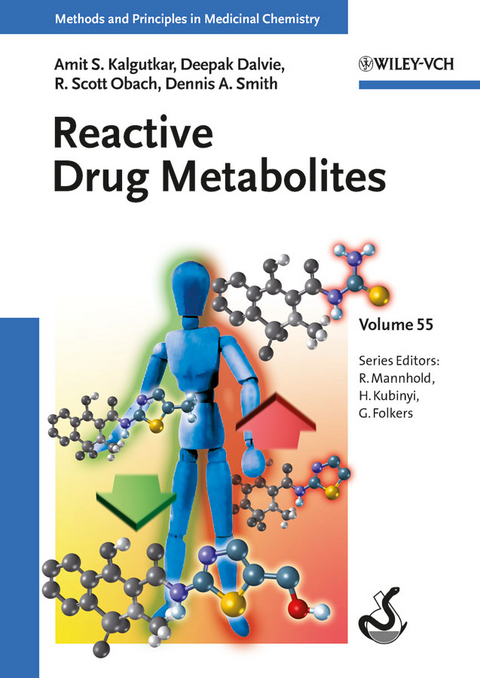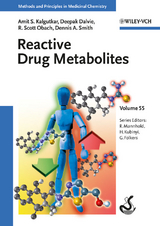Reactive Drug Metabolites
Wiley-VCH (Verlag)
978-3-527-33085-0 (ISBN)
- Titel ist leider vergriffen;
keine Neuauflage - Artikel merken
Closing a gap in the scientifi c literature, this first comprehensive introduction to the topic is based on current best practice in one of the largestpharmaceutical companies worldwide. The first chapters trace the development of our understanding of drug metabolite toxicity, covering basic concepts and techniques in the process, while the second part details chemical toxicophores that are prone to reactive metabolite formation. This section also reviews the various drug-metabolizing enzymes that can participate in catalyzing reactive metabolite formation, including a discussion of the structure-toxicity relationships for drugs. Two chapters are dedicated to the currently hot topics of herbal constituents and IADRs.The next part covers current strategies and approaches to evaluate the reactive metabolite potential of new drug candidates, both by predictiveand by bioanalytical methods. There then follows an in-depth analysis of the toxicological potential of the top 200 prescription drugs, illustratingthe power and the limits of the toxicophore concept, backed by numerous case studies. Finally, a risk-benefi t approach to managing the toxicity risk of reactive metabolite-prone drugs is presented.Since the authors carefully develop the knowledge needed, from fundamental considerations to current industry standards, no degree in pharmacology is required to read this book, making it perfect for medicinal chemists without in-depth pharmacology training.
Amit Kalgutkar received his PhD in Organic Chemistry from Virginia Polytechnic Institute (USA) and conducted a post-doctoral fellowship at the Department of Biochemistry, Vanderbilt University School of Medicine. He joined Pfi zer in 1999, where he is currently a Research Fellow in the Drug Metabolism Group (Groton Laboratories). In addition, Dr. Kalgutkar is an adjunct Professor in the Department of Biomedical and Pharmaceutical Sciences, University of Rhode Island. Deepak Dalvie received his PhD in Medicinal Chemistry from State University at New York, Buffalo (USA) and was a post-doctoral fellow at the Department of Chemistry in University of Virginia and Virginia Polytechnic Institute (USA). He joined Pfi zer in 1992, where he is currently a Research Fellow in the Pharmacokinetics, Dynamics and Metabolism Department at Pfi zer's La Jolla site. In addition, Dr. Dalvie is an Associate Editor for Drug Metabolism and Disposition and on the editorial board of Xenobiotica. Scott Obach received his PhD in biochemistry from Brandeis University and was a post-doctoral fellow at the New York State Department of Health Research Labs. He joined Pfi zer in 1992, where he is currently a Senior Research Fellow in the Pharmacokinetics, Dynamics, and Drug Metabolism Department at Pfizer in Groton (USA). In addition Dr. Obach is on the editorial boards of Drug Metabolism and Disposition, Chemical Research in Toxicology, Xenobiotica, and Drug Metabolism and Pharmacokinetics. Dennis Smith worked in the pharmaceutical industry for more than 30 years since gaining his PhD from the University of Manchester (UK). For 20 years he was at Pfi zer Global Research and Development, Sandwich, where he was Vice President-Pharmacokinetics, Dynamics and Metabolism. During this time he has helped in the Discovery and Development of eight marketed NCEs. Now retired, he is still active in an academic (Visiting Professor, University of Liverpool; Honary Professor, University of Capetown) and in an advisory capacity. He has authored over 130 publications including three books.
PREFACE
ORIGIN AND HISTORICAL PERSPECTIVE ON REACTIVE METABOLITES
Mutagenesis and Carcinogenesis
Detection of Reactive Metabolites
Induction and Inhibition: Early Probes for Reactive Metabolites and Hepatotoxicants
Covalent Binding and Oxidative Stress: Possible Mechanisms of Reactive Metabolite Cytotoxicity
Activation and Deactivation: Intoxication and Detoxification
Genetic Influences on Reactive Metabolite Formation
Halothane: the Role of Reactive Metabolites in Immune-Mediated Toxicity
Formation of Reactive Metabolites, Amount Formed, and Removal of Liability
Antibodies: Possible Clues but Inconclusive
Parent Drug and Not Reactive Metabolites, Complications in Immune-Mediated Toxicity
Reversible Pharmacology Should not be ignored as a Primary Cause of Side Effects
Conclusions: Key Points in the Introduction
ROLE OF REACTIVE METABOLITES IN GENOTOXICITY
Introduction
Carcinogenicity of Aromatic and Heteroaromatic Amines
Carcinogenicity of Nitrosamines
Carcinogenicity of Quinones and Related Compounds
Carcinogenicity of Furan
Carcinogenicity of Vinyl Halides
Carcinogenicity of Ethyl Carbamate
Carcinogenicity of Dihaloalkanes
Assays to Detect Metabolism-Dependent Genotoxicity in Drug Discovery
Case Studies in Eliminating Metabolism-Based Mutagenicity in Drug Discovery Programs
BIOACTIVATION AND INACTIVATION OF CYTOCHROME P450 AND OTHER DRUG-METABOLIZING ENZYMES
Introduction
Pharmacokinetic and Enzyme Kinetic Principles Underlying Mechanism-Based Inactivation and Drug - Drug Interactions
Mechanisms of Inactivation of Cytochrome P450 Enzymes
Examples of Drugs and Other Compounds that are Mechanism-Based Inactivators of Cytochrome P450 Enzymes
Mechanism-Based Inactivation of Other Drug-Metabolizing Enzymes
Concluding Remarks
ROLE OF REACTIVE METABOLITES IN DRUG-INDUCED TOXICITY - THE TALE OF ACETAMINOPHEN, HALOTHANE, HYDRALAZINE, AND TIENILIC ACID
Introduction
Acetaminophen
Halothane
Hydralazine
Tienilic Acid
PATHWAYS OF REACTIVE METABOLITE FORMATION WITH TOXICOPHORES/-STRUCTURAL ALERTS
Introduction
Intrinsically Reactive Toxicophores
Toxicophores that Require Bioactivation to Reactive Metabolites
Concluding Remarks
INTRINSICALLY ELECTROPHILIC COMPOUNDS AS A LIABILITY IN DRUG DISCOVERY
Introduction
Intrinsic Electrophilicity of b-Lactam Antibiotics as a Causative Factor in Toxicity
Intrinsically Electrophilic Compounds in Drug Discovery
Serendipitous Identification of Intrinsically Electrophilic Compounds in Drug Discovery
ROLE OF REACTIVE METABOLITES IN PHARMACOLOGICAL ACTION
Introduction
Drugs Activated Nonenzymatically and by Oxidative Metabolism
Bioreductive Activation of Drugs
Concluding Remarks
RETROSPECTIVE ANALYSIS OF STRUCTURE - TOXICITY RELATIONSHIPS OF DRUGS
Introduction
Irreversible Secondary Pharmacology
Primary Pharmacology and Irreversible Secondary Pharmacology
Primary or Secondary Pharmacology and Reactive Metabolites: the Possibility for False Structure - Toxicity Relationships
Multifactorial Mechanisms as Causes of Toxicity
Clear Correlation between Protein Target and Reactive Metabolites
Conclusion - Validation of Reactive Metabolites as Causes of Toxicity
BIOACTIVATION AND NATURAL PRODUCTS
Introduction
Well-Known Examples of Bioactivation of Compounds Present in Herbal Remedies
Well-Known Examples of Bioactivation of Compounds Present inFoods
Summary
EXPERIMENTAL APPROACHES TO REACTIVE METABOLITE DETECTION
Introduction
Identification of Structural Alerts and avoiding them in Drug Design
Assays for the Detection of Reactive Metabolites
Other Studies that can Show the Existence of Reactive Metabolites
Conclusion
CASE STUDIES ON ELIMINATING/REDUCING REACTIVE METABOLITE FORMATION IN DRUG DISCOVERY
Medicinal Chemistry Tactics to Eliminate Reactive Metabolite Formation
Eliminating Reactive Metabolite Formation on Heterocyclic Ring Systems
Medicinal Chemistry Strategies to Mitigate Bioactivation of Electron-Rich Aromatic Rings
Medicinal Chemistry Strategies to Mitigate Bioactivation on a Piperazine Ring System
Concluding Remarks
STRUCTURAL ALERT AND REACTIVE METABOLITE ANALYSIS FOR THE TOP 200 DRUGS IN THE US MARKET BY PRESCRIPTION
Introduction
Structural Alert and Reactive Metabolite Analyses for the Top 20 Most Prescribed Drugs in the United States for the Year 2009
Insights into the Excellent Safety Records for Reactive Metabolite - Positive Blockbuster Drugs
Structural Alert and Reactive Metabolite Analyses for the Remaining 180 Most Prescribed Drugs
Structure Toxicity Trends
MITIGATING TOXICITY RISKS WITH AFFINITY LABELING DRUG CANDIDATES
Introduction
Designing Covalent Inhibitors
Optimization of Chemical Reactivity of the Warhead Moiety
Concluding Remarks
DEALING WITH REACTIVE METABOLITE - POSITIVE COMPOUNDS IN DRUG DISCOVERY
Introduction
Avoiding the Use of Structural Alerts in Drug Design
Structural Alert and Reactive Metabolite Formation
Should Reactive Metabolite - Positive Compounds be nominated as Drug Candidates?
The Multifactorial Nature of IADRs
Concluding Remarks
MANAGING IADRS ' A RISK' BENEFIT ANALYSIS
Risk - Benefit Analysis
How common is Clinical Drug Toxicity?
Rules and Laws of Drug Toxicity
Difficulties in Defining Cause and Black Box Warnings
Labeling Changes, Contraindications, and Warnings: the Effectiveness of Side Effect Monitoring
Allele Association with Hypersensitivity Induced by Abacavir: Toward a Biomarker for Toxicity
More Questions than Answers: Benefit Risk for ADRs
INDEX
| Erscheint lt. Verlag | 29.10.2012 |
|---|---|
| Reihe/Serie | Methods and Principles in Medicinal Chemistry ; 55 |
| Mitarbeit |
Herausgeber (Serie): Raimund Mannhold, Hugo Kubinyi, Gerd Folkers |
| Verlagsort | Weinheim |
| Sprache | englisch |
| Maße | 170 x 240 mm |
| Gewicht | 1012 g |
| Themenwelt | Medizin / Pharmazie ► Medizinische Fachgebiete ► Pharmakologie / Pharmakotherapie |
| Medizin / Pharmazie ► Pharmazie | |
| Studium ► 1. Studienabschnitt (Vorklinik) ► Biochemie / Molekularbiologie | |
| Naturwissenschaften ► Chemie | |
| Schlagworte | Arzneimittel • Basic Pharmacology • Chemie • Chemistry • Drug Discovery & Development • Drug Discovery & Development • Grundlagen der Pharmakologie • Medical Science • Medizin • Toxicology • Toxikologie • Wirkstoffforschung • Wirkstoffforschung u. -entwicklung |
| ISBN-10 | 3-527-33085-2 / 3527330852 |
| ISBN-13 | 978-3-527-33085-0 / 9783527330850 |
| Zustand | Neuware |
| Haben Sie eine Frage zum Produkt? |
aus dem Bereich




